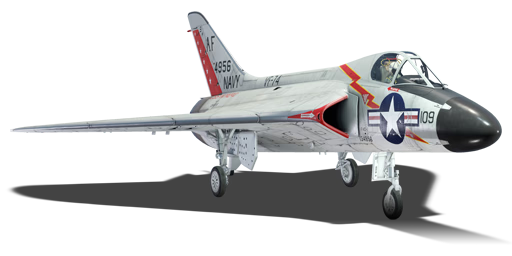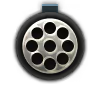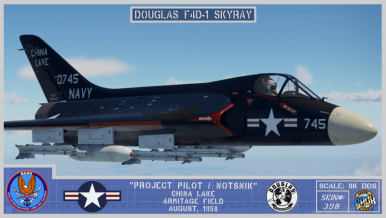

The origins of the F4D Skyray can be traced to the German studies in more aerodynamic wing designs for high speed manoeuvres with the Me 163. Alexander Martin Lippisch, the creator of this fighter, was brought back to the US together with other German engineers after the end of WWII. With the emergence of new high speed bombers like the Tu-16, the USN decided to create a new interceptor capable of dealing with this aircraft. The XF4D was built in 1951 and was equipped with a Westinghouse J40-WE-8 engine with afterburner after considering it superior to proposed turbojet engines. The tests were carried out for 5 years, and after that the USN became the first user of this interceptor, later the USMC and NACA (later known as NASA) would also use this fighter. The F4D lived a relatively short life, since it was retired in 1964, when more capable multirole aircrafts like the F-4 Phantom II appeared, that were capable of not only dealing with enemy bombers, but also engaging in long range combat and close air support.
It was introduced during Update "Danger Zone" as a reward for the 2022 Summer Quest event. The last subsonic carrier-based jet fighter adapted into USN service by Douglas, the Skyray offers sufficient speed at its rank with a large wing, boosting its overall climb rate and allowing it to fly in transonic speeds without any fatal structural damage. However, players do have to beware of its outdated design of wing-mounted guns, whereas most jets of the era put them on the centreline instead, as well as severe bleeding of speed in manoeuvres due to the large wing. With access to 4 x AIM-9B air to air missiles, it is a good option for players considering a support fighter at rank VI, with the ability to also dogfight most opponents. For ground attack, it has access to a large amount of FFAR Mighty Mouse rockets, but it should be noted, that most of this rockets use the same pylons as the missiles, so carrying a full load of missiles and rockets at the same time is not possible.
flaps
flaps
flaps
brake
| Belt | Belt filling | Armor penetration (mm) at a distance: | |||||
|---|---|---|---|---|---|---|---|
| 10 m | 100 m | 500 m | 1000 m | 1500 m | 2000 m | ||
| AP-T/HEI/HEI | 42 | 39 | 27 | 18 | 11 | 7 | |
| AP-T/HEI | 42 | 39 | 27 | 18 | 11 | 7 | |
| AP-T/HEI/AP-I/HEI | 42 | 39 | 27 | 18 | 11 | 7 | |
| AP-T/AP-T/HEI/AP-I | 42 | 39 | 27 | 18 | 11 | 7 | |
| AP-I/HEI/HEI/HEI | 42 | 39 | 27 | 18 | 11 | 7 | |
| Belt | Belt filling | Armor penetration (mm) at a distance: | |||||
|---|---|---|---|---|---|---|---|
| 10 m | 100 m | 500 m | 1000 m | 1500 m | 2000 m | ||
| AP-T/HEI/HEI | 42 | 39 | 27 | 18 | 11 | 7 | |
| AP-T/HEI | 42 | 39 | 27 | 18 | 11 | 7 | |
| AP-T/HEI/AP-I/HEI | 42 | 39 | 27 | 18 | 11 | 7 | |
| AP-T/AP-T/HEI/AP-I | 42 | 39 | 27 | 18 | 11 | 7 | |
| AP-I/HEI/HEI/HEI | 42 | 39 | 27 | 18 | 11 | 7 | |
| Name | Weight | Slot | ||||||
|---|---|---|---|---|---|---|---|---|
| 72.6 kg |  |  |  |  | ||||
| 7 × | 93.3 kg |  |  |  |  |  |  | |
| 19 × | 233.7 kg |  |  |  |  |  |  | |












Flight performance | |
|---|---|
Survivability |
|---|
Weaponry | ||
|---|---|---|
